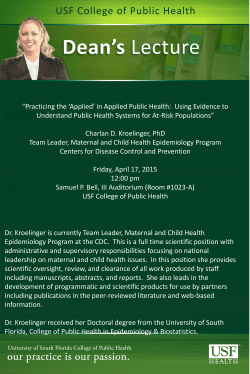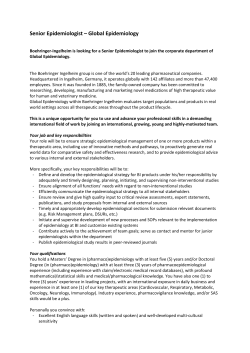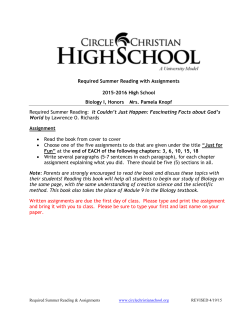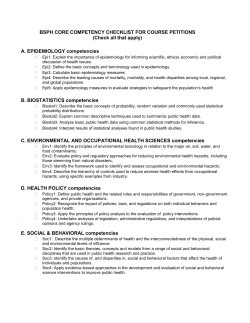
social and behavioral determinants of health
Department of Nutrition, Food Studies & Public Health PUHE-GE 2306 / GPH-GU 2106: Epidemiology SPRING 2014 INSTRUCTOR INFORMATION Professor: Farzana Kapadia, PhD MPH Phone: 212-998-5223 Email: farzana.kapadia@nyu.edu Office: 411 Lafayette Street, Room 523 Office hours: Thursdays, 2:30 – 4:30pm COURSE INFORMATION: Lecture: Wednesday, 4:55 – 6:35pm, Room: Silver 207 Discussion Sections: Section 2: Wednesdays, 6:45 – 8:25pm, Room: Waverly 370 TA: Pricila Mullachery, MPH Office hours: By appointment Email: pm1393@nyu.edu Section 3, Wednesdays, 6:45 – 8:25pm, Room: Waverly 566A TA: Julie Kranick, MA Office hours: By appointment Email: juliekranick87@gmail.com Section 5, Thursdays, 6:45 – 8:25pm, Room: Waverly 433 TA: Priti Bandi, MPH Office hours: By appointment Email: pb1349@nyu.edu Section 6, Thursdays, 6:45 – 8:25pm, Room: Waverly 431 TA: Maggie Giorgio, MPH Office hours: By appointment Email: maggie.giorgio@gmail.com COURSE DESCRIPTION Epidemiology is the study of the distribution and determinants of health and disease in different human populations and the application of methods to improve disease outcomes. As such, epidemiology is the basic science of public health. This course is designed to introduce students in all fields of public health to the background, basic principles and methods of public health epidemiology. Topics covered include: basic principles of epidemiology; measures of disease frequency; epidemiologic study designs: experimental and observational; bias; confounding; outbreak investigations; screening; -1- causality; and ethical issues in epidemiologic research. In addition, students will develop skills to read, interpret and evaluate health information from published epidemiologic studies. This course has two main components: a lecture and a discussion section; attending both lecture and discussion sections are equally important to ensuring success in the course. All students are required to attend lecture sessions and participate in their discussion sections. The discussion sections will be led by a graduate teaching assistant (TA) and will include a discussion of lecture materials covered that week and a review of homework assignments due that week. For some discussion sections, students will have an opportunity to take part in a series of ‘hands on’ exercises developed to provide a fuller understanding of concepts covered in previous lectures and homework assignments. LEARNING OBJECTIVES By the end of this course students will develop the ability to: 1. Explain the role of epidemiology in the field of public health. 2. List and describe epidemiological approaches to defining and measuring health problems in defined populations. 3. Understand the various epidemiologic study designs and be able to compare the strengths and weaknesses of each. 4. Identify and describe various sources of bias and confounding in epidemiologic studies 5. Understand the concepts of screening and testing in a range of health and other settings. 6. Understand and apply epidemiological criteria needed to establish causal relationships. 7. Understand, and apply key ethical issues to the conduct of epidemiological and other scientific investigations. 8. Critically read and evaluate epidemiologic studies in the medical or public health literature. READINGS Required: 1. Aschengrau A & Seage GR. Essentials of Epidemiology in Public Health. 3rd Edition (2014). 2. Additional required readings will be assigned to supplement the main textbook or as part of various homework assignments; a list of these is provided on the next page and will be made available to students via the class blackboard. I also reserve the right to add readings during the course of the semester as appropriate. Additional resources: 1. A good online text: Principles of Epidemiology: An Introduction to Applied Epidemiology and Biostatistics. Second Edition. It is available at: http://www.phppo.cdc.gov/PHTN/catalog/pdffile/Epi_Course.pdf 2. Epidemiology, the Internet and Global Health. An online compilation of hundreds of lectures on a wide variety of topics; I would recommend this site to anyone interested in further reading on a specific subject area. The site can be accessed at http://www.pitt.edu/~super1/ And this is just the beginning. There are a number of textbooks based on content area, level of expertise, etc. as well several websites. If you have a specific area of interest in mind, please let me know and I will be happy to provide additional resources. -2- REQUIREMENTS 1. Students are expected to attend all lecture and discussion sessions. Active participation in the discussion sessions is also expected and highly encouraged. If you cannot attend a certain discussion session, it is your responsibility to notify the appropriate TA beforehand, or in the case of an emergency, immediately upon return. All other absences will be considered unexcused. In addition, students are expected to come to class on time to prevent disrupting the lecture and classroom activities. 2. Complete reading assignments prior to class. Readings are listed in the course schedule on pages 4 – 6 and additional readings may be assigned as needed. 3. Complete homework assignments (5): Homework assignments are due on the dates noted below. They are to be handed in at the beginning of lecture – late homework will not be accepted. If you cannot make it to class, it is your responsibility to notify the appropriate TA ahead of time and make arrangements to turn in your homework via email on or before the due date. You can rely on your class notes or other supplemental materials to complete your assignment, but it is an individual effort so do not share answers with others! NOTE: All homework assignments must be typed (1” margins, Times New Roman 12pt or Arial 11pt font – no smaller and no larger – no exceptions!). Calculations may be neatly handwritten. Your name must be on the top of each page that you hand in. Homework Due Dates: Assignment 1: Assignment 2: Assignment 3: Assignment 4: Assignment 5: February 19th, 2014 March 5th, 2014 April 2nd, 2014 April 16th, 2014 May 7th, 2014 4. Midterm Exam: An in-class, closed book examination including multiple choice, calculations and short answers items. The exam will cover materials presented in lectures 1 – 7. 5. Final Exam: An in-class, closed book examination including multiple choice, calculations and short answers items. The exam will cover materials presented in lectures 8 – 13. 6. Grading: 1. Homework assignments(5 x 9 pts): 2. Participation in discussion section: 3. Midterm: 4. Final: 45 pts 5 pts 25 pts 25 pts NOTE: If you have questions about grades on any assignment or exam, please speak to the instructor within 3 days of receiving said grade. After this timeframe, I will not entertain grading disputes. 7. Any student attending NYU who needs an accommodation due to a chronic, psychological, visual, mobility and/or learning disability, or is Deaf or Hard of Hearing should register with the Moses Center for Students with Disabilities at 212 998-4980, 240 Greene Street, www.nyu.edu/csd -3- COURSE SCHEDULE 1 Date Jan 29th Lecture Topic - Course overview - Historical Development - Basic principles of epidemiology 2 Feb 5th - General Health and Population Indicators - Measures of morbidity 3 Feb 12th - Measures of mortality - Direct & Indirect age adjustment 4 Feb 19th - Cross-Sectional studies - Ecologic studies ASSIGNMENT #1 DUE Reading Assignment Due Recommended: 1. Aschengrau & Seage, Chapter 1 2. Winkelstein W. Interface of epidemiology and history: A commentary on past, present and future. Epidemiologic Reviews. 2000;22:2-6. 3. Armenian HK. Epidemiology: A problem solving journey. American Journal of Epidemiology. 2009;169:127–131. Required: 1. Aschengrau & Seage, Chapter 2 2. Browse: SEER website, State Cancer Profiles at: http://seer.cancer.gov/statistics/scp.html (incidence rate data) 3. Gershon et al. Trends in asthma prevalence and incidence in Ontario, Canada, 1996 – 2005: A population study. AJE. 2010;172:728-736. Recommended: 1. ERIC Notebook: Incidence vs. Prevalence 2. ERIC Notebook: Calculating Person-Time Required: 1. Aschengrau & Seage, Chapter 3 pgs 69 - 73 2. CDC Stat Notes: Klein, Age Adjustment 3. Browse: SEER website, State Cancer Profiles at: http://seer.cancer.gov/statistics/scp.html (death rate data) 4. Gershon et al. Trends in asthma prevalence and incidence in Ontario, Canada, 1996 – 2005: A population study. AJE. 2010;172:728-736. Recommended: 1. Wang et al. Age-specific and sex-specific mortality in 187 countries, 1970–2010: a systematic analysis for the Global Burden of Disease Study 2010. Lancet 2012; 380: 2071–94. Required: 1. Aschengrau & Seage, Chapter 4 2. Browse: NCHS website: Surveys & Data Collection Systems (http://www.cdc.gov/nchs/surveys.htm) 3. Roberts et al. Cross-sectional association between perceived discrimination and hypertension in African-American men and women. AJE. 2008;167:624-632. 4. Wheeler BW, Allen J, Depledge MH, Curnow A. Radon and skin cancer in south-west England: an ecologic study. Epidemiology. 2012;23:44–52. Recommended: 1. Grimes & Schulz: Descriptive Studies 2. ERIC Notebook: Ecologic Studies 3. ERIC Notebook: Cross Sectional Studies -4- COURSE SCHEDULE 5 Date Feb 26th Lecture Topic - Cohort studies 6 Mar 5th - Case-Control studies ASSIGNMENT #2 DUE 7 8 9 Mar 12th Mar 19th Mar 26th - Randomized Trials Reading Assignment Due Required: 1. Aschengrau & Seage, Chapter 3 pgs 59 - 69 2. Aschengrau & Seage, Chapter 8 3. The Nurses Health Study: http://www.channing.harvard.edu/nhs/ 4. Oh et al. Dietary fat intake and risk of coronary heart disease in women: 20 years of follow-up of the Nurses’ Health Study. AJE. 2005;161:672-679. Recommended: 1. Grimes & Schulz: Cohort Studies Required: 1. Aschengrau & Seage, Chapter 9 2. Vineis et al. Environmental tobacco smoke and risk of respiratory cancer and chronic obstructive pulmonary disease in former smokers and never smokers in the EPIC prospective study. BMJ. 2005;330:1-5. 3. Press, DJ & Pharoah, P. Risk Factors for Breast Cancer: A Reanalysis of Two Case-control Studies From 1926 and 1931. Epidemiology. 2010;21(4):566-572. Recommended: 1. Schulz & Grimes: Case-Control Studies MIDTERM EXAM Spring Break – No Class Required: 1. Aschengrau & Seage, Chapter 7 2. CONSORT guidelines: http://www.consort-statement.org/ 3. Grimes & Schulz: Overview of clinical research 4. Padian et al. Diaphragm and lubricant gel for prevention of HIV acquisition in southern African women: a randomized controlled trial. Lancet. 2007;370:251-261. 5. Auvert et al. Randomized, Controlled Intervention Trial of Male Circumcision for Reduction of HIV Infection Risk: The ANRS 1265 Trial. 2005. PLoS Med 2(11): e298. 6. Metsch et al. Effect of risk-reduction counseling with rapid HIV testing on risk of acquiring sexually transmitted infections: the AWARE randomized clinical trial. 2013. JAMA. Oct 23;310(16):1701-10. Recommended: 1. Schulz & Grimes: Blinding 2. Schulz & Grimes: Allocation concealment 2. Schulz & Grimes: Generation of allocation sequences -5- COURSE SCHEDULE 10 Date Apr 2nd Lecture Topic - Selection and Information Bias ASSIGNMENT #3 DUE 11 Apr 9th - Confounding 12 Apr 16th 13 Apr 23rd - Effect Modification - Causal inference ASSIGNMENT #4 DUE - Screening 14 Apr 30th - Outbreak investigations 15 May 7th - Social Epidemiology Reading Assignment Due Required: 1. Aschengrau & Seage, Chapter 10 2. Aschengrau & Seage, Chapter 12 pgs 307 – 317 3. Wilcox AJ et al. Folic acid supplements and risk of facial clefts: national population based casecontrol study. BMJ. 2007; 334:464-469. 4. Paganini-Hill et al. Responders Versus Nonresponders in a Dementia Study of the Oldest Old: The 90+ Study. AJE. 2013;177(12):1452-8. Recommended: 1. Grimes & Schulz, Bias and causal associations Required: 1. Aschengrau & Seage, Chapter 11 2. Wilcox AJ et al. Folic acid supplements and risk of facial clefts: national population based casecontrol study. BMJ. 2007; 334:464-469. Recommended: 1. Grimes & Schulz, Bias and causal associations Required: 1. Aschengrau & Seage, Chapters 13 & 15 2. Bradford Hill, The environment and disease Required: 1. Aschengrau & Seage, Chapter 16 2. Andersson et al. Mammographic screening and mortality from breast cancer: the Malmo mammographic screening trial. BMJ. 1988;297:943-949. Recommended: 1. Grimes & Schulz, Screening tests Required: 1. Reingold A. Outbreak investigations – a perspective. 2. Domınguez A, et al. Large Outbreak of Measles in a Community with High Vaccination Coverage: Implications for the Vaccination Schedule. Clinical Infectious Diseases. 2008; 47:1143–9. 3. Centers for Disease Control and Prevention. Increased Transmission and Outbreaks of Measles — European Region, 2011. MMWR. 2011;60(47)1605-1610. Required: 1. To be assigned ASSIGNMENT #5 DUE TBA FINAL EXAM -6- STATEMENT ON ACADEMIC INTEGRITY* “Your degree should represent genuine learning” The relationship between students and faculty is the keystone of the educational experience in The Steinhardt School of Education at New York University. This relationship takes an honor code for granted. Mutual trust, respect and responsibility are foundational requirements. Thus, how you learn is as important as what you learn. A University education aims not only to produce high quality scholars, but also to cultivate honorable citizens. Academic integrity is the guiding principle for all that you do, from taking exams, making oral presentations to writing term papers. It requires that you recognize and acknowledge information derived from others, and take credit only for ideas and work that are yours. You violate the principle of academic integrity when you: Cheat on an exam; Submit the same work for two different courses without prior permission from your professors; Receive help on a take-home examination that calls for independent work; Plagiarize Plagiarism, one of the gravest forms of academic dishonesty in university life, whether intended or not, is academic fraud. In a community of scholars, whose members are teaching, learning and discovering knowledge, plagiarism cannot be tolerated. Plagiarism is failure to properly assign authorship to a paper, a document, an oral presentation, a musical score and/or other materials which are not your original work. You plagiarize when, without proper attribution, you do any of the following: Copy verbatim from a book, an article or other media; Download documents from the Internet; Purchase documents; Report from other’s oral work; Paraphrase or restate someone else’s facts, analysis and/or conclusions; Copy directly from a classmate or allow a classmate to copy from you. Your professors are responsible for helping you to understand other people’s ideas, to use resources and conscientiously acknowledge them, and to develop and clarify your own thinking. You should know what constitutes good and honest scholarship, style guide preferences, and formats for assignments for each of your courses. Consult your professors for help with problems related to fulfilling course assignments, including questions related to attribution of sources. -7- Through reading, writing and discussion, you will undoubtedly acquire ideas from others, and exchange ideas and opinions with others, including your classmates and professors. You will be expected, and often required, to build your own work on that of other people. In so doing, you are expected to credit those sources that have contributed to the development of your ideas. Avoiding Academic Dishonesty Organize your time appropriately to avoid undue pressure, and acquire good study habits, including note taking. Learn proper forms of citation. Always check with your professors of record for their preferred style guides. Directly copies material must always be in quotes; paraphrased material must be acknowledged; even ideas and organization derived from your own previous work or another’s work need to be acknowledged. Always proofread your finished work to be sure that quotation marks or footnotes or other references were not inadvertently omitted. Know the source of each citation. Do not submit the same work for more than one class without first obtaining the permission of both professors even if you believe that work you have already completed satisfies the requirements of another assignment. Save your notes and drafts of your papers as evidence of your original work. Disciplinary Sanctions When a professor suspects cheating, plagiarism, and/or other forms of academic dishonesty, appropriate disciplinary action is as follows: The Professor will meet with the student to discuss, and present evidence for the particular violation, giving the student opportunity to refute or deny the charge(s). If the Professor confirms that violation(s), he/she, in consultation with the Program Director and Department Chair may take any of the following actions: - Allow the student to redo the assignment - Lower the grade for the work in question - Assign a grade of F for the work in question - Assign a grade of F for the course - Recommend dismissal Once an action(s) is taken, the Professor will inform the Program Director and Department Chair, and inform the student in writing, instructing the student to schedule an appointment with the Associate Dean for Student Services and Public Affairs, as a final step. Copies of the letter will be sent to the Department Chair for his/her confidential student file and the Associate Dean for Student Services and Public Affairs. The student has the right to appeal the action taken in accordance with the School’s Student Complaint Procedure as outlined in The Steinhardt School of Education Student Handbook. When dismissal is recommended, that recommendation will be forwarded to the Associate Dean for Student Services and Public Affairs, who will convene all parties involved. An appeal of the decision at this step is submitted in writing to the Vice Dean, including full documentation to support the appeal. *The Steinhardt School of Education Statement on Academic Integrity is consistent with New York University Policy on Student Conduct, published in the NYU Student Guide. -8-
© Copyright 2025









